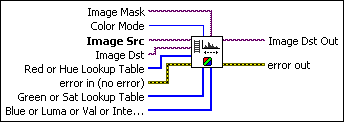IMAQ ColorUserLookup VI
Owning Palette: Color ProcessingInstalled With: NI Vision Development ModuleApplies a lookup table (LUT) to each color plane.



 |
Image Mask is an 8-bit image that specifies the region of the small image that will be copied. Only those pixels in the Image Src (Small) image that correspond to an equivalent non-zero pixel in the mask image are copied. All other pixels keep their original values. The entire image is processed if Image Mask is not connected. |
||||||||||
 |
Color Mode defines the image color format to use for the operation. Choose from the following values:
|
||||||||||
 |
Image Src is a reference to the source image. |
||||||||||
 |
Image Dst is a reference to the destination image. |
||||||||||
 |
Red or Hue Lookup Table is the LUT applied to the first color plane, depending on the Color Mode. This array can contain a maximum of 256 elements. The array is filled automatically when you specify fewer than 256 elements. This procedure does not change pixel values that are not explicitly specified from the values of the LUT you input. By default this array is empty, and no replacement occurs on this plane. |
||||||||||
 |
error in (no error) describes the error status before this VI or function runs. The default is no error. If an error occurred before this VI or function runs, the VI or function passes the error in value to error out. This VI or function runs normally only if no error occurred before this VI or function runs. If an error occurs while this VI or function runs, it runs normally and sets its own error status in error out. Use the Simple Error Handler or General Error Handler VIs to display the description of the error code. Use error in and error out to check errors and to specify execution order by wiring error out from one node to error in of the next node.
|
||||||||||
 |
Green or Sat Lookup Table is the LUT applied to the second color plane, depending on the Color Mode. This array can contain a maximum of 256 elements. The array is filled automatically when you specify fewer than 256 elements. This procedure does not change pixel values that are not explicitly specified from the values of the LUT you input. By default this array is empty, and no replacement occurs on this plane. |
||||||||||
 |
Blue or Luma or Val or Inten Lookup Table is the LUT applied to the third color plane, depending on the Color Mode. This array can contain a maximum of 256 elements. The array is filled automatically when you specify fewer than 256 elements. This procedure does not change pixel values that are not explicitly specified from the values of the LUT you input. By default this array is empty, and no replacement occurs on this plane. |
||||||||||
 |
Image Dst Out is a reference to the destination image. If Image Dst is connected, Image Dst Out is the same as Image Dst. Otherwise, Image Dst Out refers to the image referenced by Image Src. |
||||||||||
 |
error out contains error information. If error in indicates that an error occurred before this VI or function ran, error out contains the same error information. Otherwise, it describes the error status that this VI or function produces. Right-click the error out indicator on the front panel and select Explain Error from the shortcut menu for more information about the error.
|






